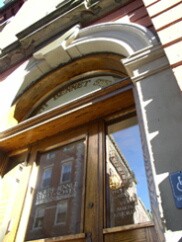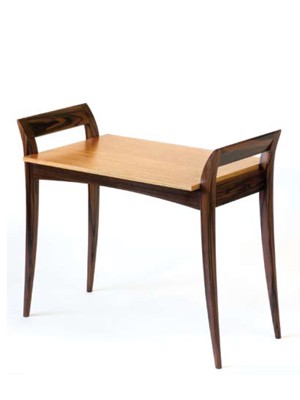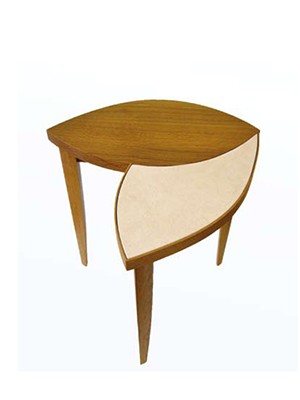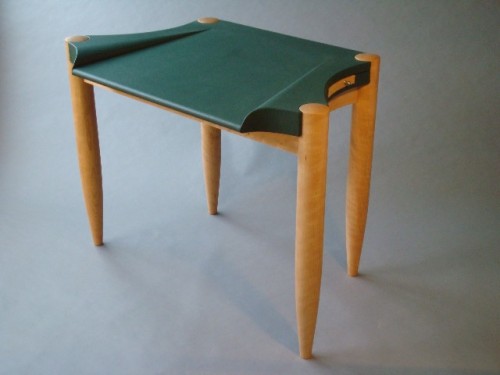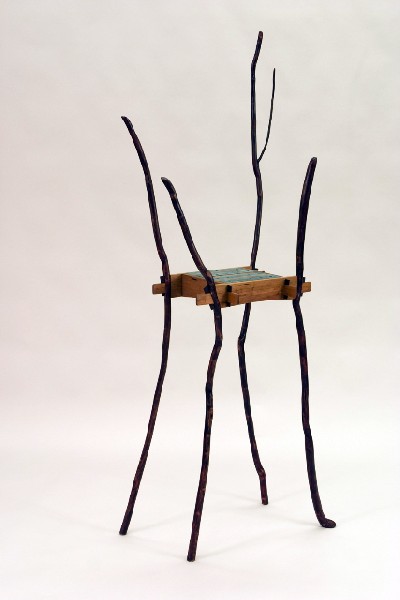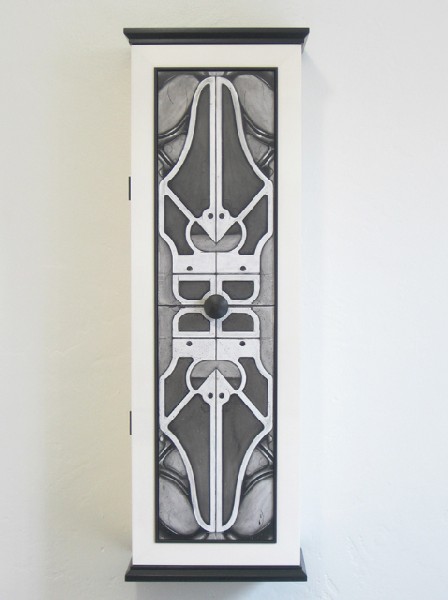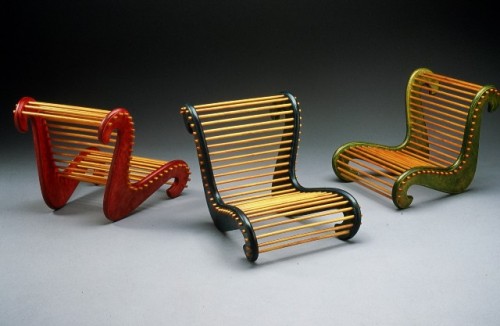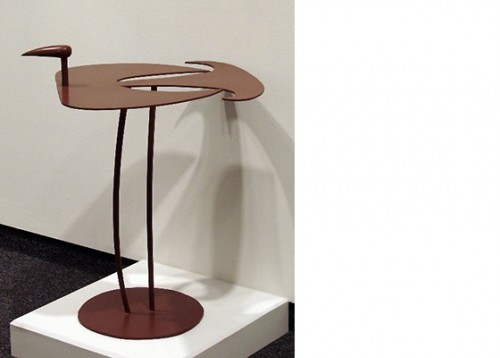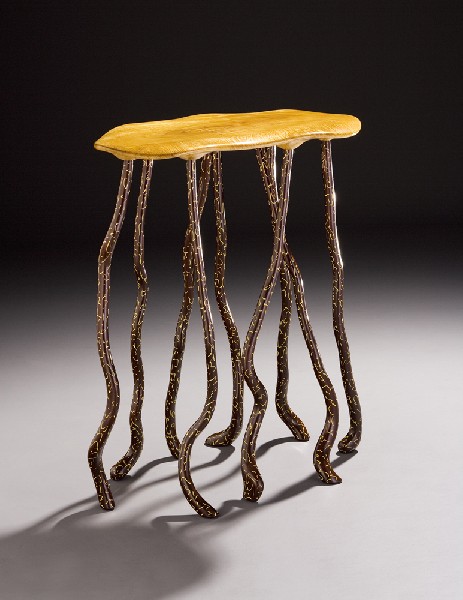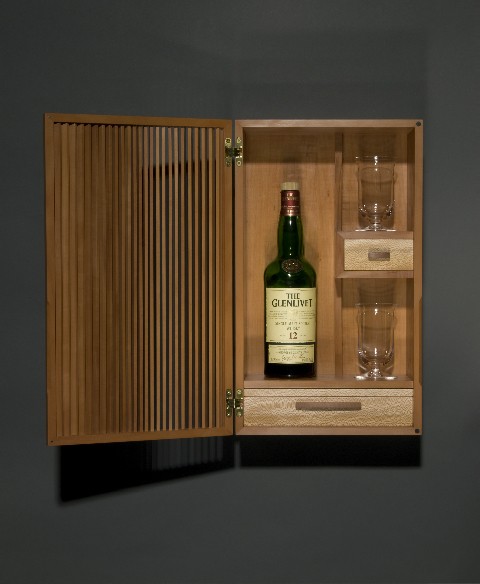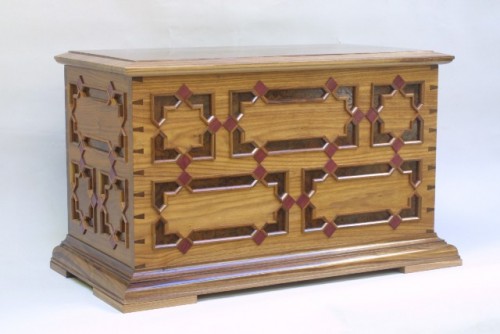Gallery NAGA Exhibit For North Bennet Street School
Studio Furniture Benefit Celebrating 125 Years
By: Mark Favermann - Mar 13, 2010
How appropriate it is that the Gallery NAGA, among other things the premiere studio furniture venue in America, is hosting a benefit exhibition for the North Bennet Street School. This exhibit is celebrating the 125th anniversary of the school's founding in the North End of Boston. Gallery NAGA is showcasing pieces by 28 studio furniture makers. Generously, the Gallery and artists are donating 50% to the school from sales of the works.
The North Bennet Street School has been training people for employment in fine craftsmanship since 1885. The school pioneered the concept of intensive instruction in a classroom/shop setting for the sole purpose of learning a trade. All courses prepare graduates for work in fields that require craftsmanship. Craftsmanship is defined as "the skillful use of hand tools or power equipment; informed choice of appropriate materials; Knowledge and creative problem-solving grounded in awareness of the best solutions of the craft over many years; and a commitment to the highest quality of work."
Over the past century and a quarter, the North Bennet Street School has had a reputation for distinguished excellence. It is thoughtfully considered more than just a school where students learn the comprehensive elements of their chosen fields, but one of the now few places that sustains tradition in craftsmanship. Begun as a trade school for immigrants and their children, today students come from all over the world to enroll in programs on cabinet and furniture making, jewelry making and repair, bookbinding, preservation carpentry, violin making and repair, locksmithing and piano technology. Though somewhat diverse, all the disciplines taught are tied together by the school's mission to have students learn the skills and methods that produce work of the highest standards possible.
In the latter part of the 19th Century, Boston had three training schools for three different segments of the population, actually three different social classes. The North Bennet Street School was founded to train the increasing influx of generally poor European immigrants. The Massachusetts Normal Art School was founded in 1873 for the training of the general (middle class) population in skills in the arts and design. This school later became the Massachusetts College of Art and Design. The third school was at the Boston Museum of Fine Arts, the Museum School. Founded in 1876, it was to train members of the upper classes. The Brahmin architectural brothers Charles Sumner Greene and Henry Mather Greene (Greene & Greene) took classes there while studying at M.I.T. Today, things are much more democratic at all of the institutions.
A few of the most prominent furniture makers exhibiting in the Gallery NAGA show are Gary Knox Bennett, Judy Kensley McKee, Jere Osgood and Rosanne Somerson. These individuals are mature practitioners with wide and distinguished reputations. Somerson heads the furniture program at the Rhode Island School of Design. Her piece included in the show, Small Table, plays the two joined leaf-shaped top surfaces against each other, one is warm oak and the other is a cool limestone. Like many of the other and varied pieces exhibited, this table is small, even petite.
Also included are younger artist/designers who are even new to followers of the studio furniture field. One, Ben Fleis of Ithaca, New York is represented by Scotch and a Cigar-Drinks Cabinet. This piece has a pear and sycamore interior to house fine cigars and and an excellent single malt scotch. Another newcomer is Niswonger of Worthington, Massachusetts. His elegant piece is Green Cabinet. Its top and side panels are pale green cast urethane sculpted with deep, wave-shaped contours. There piece expresses a translucency that is jewel-like, solid but somehow almost liquid.
There are many notable pieces in the exhibit. Of course Judy McKee's Small Bird Table piece is sleek with her suggestion of whimsey and character. Timothy Philbrick's Tray Table is elegant and minimalist without being minimal. Steve Whittlesley's Rest has an edginess that also references primitive tribal art. Jon Brook's Citron Alter has an organic quality that is also witty. Tim Ryerson's Harp Chairs harken back to fifties lawn chairs hybridized with colorful musical string instruments. Todd Partridge's Untitled is a study in black and white that merges contemporary graphics with elegant cabinet making.
Miguel Gomez-Ibanez, the Director of the North Bennet Street School, also is included in the show. His beautifully crafted chest with walnut burl and purpleheart veneers is based upon a geometric Islamic pattern usually seen in ceramic tile work from the 14th Century. Born and partially raised in Spain, the Moorish influence is something that he has always loved and even been "mesmerized" by since boyhood. This is because Islamic art does not allow the human figure, so intricacy and pattern induce a state of trancelike reflection. For whatever reason, it is an elegant, evocative work.
In a series of questions, galleryist Arthur Dion (aka, the Godfather of Studio Furniture), discussed with Mr. Gomez-Ibanez the craft world in general, the North Bennet Street School and his own career.
Arthur Dion: Many Boston organizations reach the age of 125. Why is the North Bennet Street School's 125 anniversary so important?
Miguel Gomez-Ibanez: I think that craft world is relatively unique. In Boston in the late 19th century, there was a very vibrant arts and crafts movement that spawned North Bennet Street and then the Society of Arts and Crafts. While we may not have as long a history as other Boston groups, in the craft world it's very long.
Arthur Dion: In addition to much of your furniture making time, what else did you have to redirect when you became North Bennet street's executive director?
Miguel Gomez-Ibanez: Nothing. The job fit all of the accumulated experience that I had from four different careers perfectly.
Dion: And those were?
Miguel Gomez-Ibanez: In the Navy, I was a carpenter in the Seabees. After that I was a journalist and then I became an architect, and then I was a furniture maker and also president of the Furniture Society (a national organization of furniture makers). I think that all of these gave me what I needed at North Bennet Street.
Dion: Why is the fraternity of furniture makers so close knit?
Miguel Gomez-Ibanez: People enter the field without the expectation of terrific financial reward. They enter the field because they love it. So you're in the company of people who love what they do.
Dion: How do you expect the North Bennet Street community to respond to this exhibition?
Miguel Gomez-Ibanez: I expect them to love the furniture and to be moved by the regard evidenced by the school.
This Gallery NAGA exhibit For North Bennet Street is an excellent and comprehensive group show. It is a wonderful, varied showcase of high standards, historic acknowledgement, contemporary craftsmanship, individual skill and artistic inspiration. It mirrors the quality and mission of the school that it is benefiting, the North Bennet Street School.
At Gallery NAGA March 5-27, 67 Newbury Street, Boston, MA, open Tuesdays through Saturdays, 10 AM to 5 PM
The North Bennet Street School has been training people for employment in fine craftsmanship since 1885. The school pioneered the concept of intensive instruction in a classroom/shop setting for the sole purpose of learning a trade. All courses prepare graduates for work in fields that require craftsmanship. Craftsmanship is defined as "the skillful use of hand tools or power equipment; informed choice of appropriate materials; Knowledge and creative problem-solving grounded in awareness of the best solutions of the craft over many years; and a commitment to the highest quality of work."
Over the past century and a quarter, the North Bennet Street School has had a reputation for distinguished excellence. It is thoughtfully considered more than just a school where students learn the comprehensive elements of their chosen fields, but one of the now few places that sustains tradition in craftsmanship. Begun as a trade school for immigrants and their children, today students come from all over the world to enroll in programs on cabinet and furniture making, jewelry making and repair, bookbinding, preservation carpentry, violin making and repair, locksmithing and piano technology. Though somewhat diverse, all the disciplines taught are tied together by the school's mission to have students learn the skills and methods that produce work of the highest standards possible.
In the latter part of the 19th Century, Boston had three training schools for three different segments of the population, actually three different social classes. The North Bennet Street School was founded to train the increasing influx of generally poor European immigrants. The Massachusetts Normal Art School was founded in 1873 for the training of the general (middle class) population in skills in the arts and design. This school later became the Massachusetts College of Art and Design. The third school was at the Boston Museum of Fine Arts, the Museum School. Founded in 1876, it was to train members of the upper classes. The Brahmin architectural brothers Charles Sumner Greene and Henry Mather Greene (Greene & Greene) took classes there while studying at M.I.T. Today, things are much more democratic at all of the institutions.
A few of the most prominent furniture makers exhibiting in the Gallery NAGA show are Gary Knox Bennett, Judy Kensley McKee, Jere Osgood and Rosanne Somerson. These individuals are mature practitioners with wide and distinguished reputations. Somerson heads the furniture program at the Rhode Island School of Design. Her piece included in the show, Small Table, plays the two joined leaf-shaped top surfaces against each other, one is warm oak and the other is a cool limestone. Like many of the other and varied pieces exhibited, this table is small, even petite.
Also included are younger artist/designers who are even new to followers of the studio furniture field. One, Ben Fleis of Ithaca, New York is represented by Scotch and a Cigar-Drinks Cabinet. This piece has a pear and sycamore interior to house fine cigars and and an excellent single malt scotch. Another newcomer is Niswonger of Worthington, Massachusetts. His elegant piece is Green Cabinet. Its top and side panels are pale green cast urethane sculpted with deep, wave-shaped contours. There piece expresses a translucency that is jewel-like, solid but somehow almost liquid.
There are many notable pieces in the exhibit. Of course Judy McKee's Small Bird Table piece is sleek with her suggestion of whimsey and character. Timothy Philbrick's Tray Table is elegant and minimalist without being minimal. Steve Whittlesley's Rest has an edginess that also references primitive tribal art. Jon Brook's Citron Alter has an organic quality that is also witty. Tim Ryerson's Harp Chairs harken back to fifties lawn chairs hybridized with colorful musical string instruments. Todd Partridge's Untitled is a study in black and white that merges contemporary graphics with elegant cabinet making.
Miguel Gomez-Ibanez, the Director of the North Bennet Street School, also is included in the show. His beautifully crafted chest with walnut burl and purpleheart veneers is based upon a geometric Islamic pattern usually seen in ceramic tile work from the 14th Century. Born and partially raised in Spain, the Moorish influence is something that he has always loved and even been "mesmerized" by since boyhood. This is because Islamic art does not allow the human figure, so intricacy and pattern induce a state of trancelike reflection. For whatever reason, it is an elegant, evocative work.
In a series of questions, galleryist Arthur Dion (aka, the Godfather of Studio Furniture), discussed with Mr. Gomez-Ibanez the craft world in general, the North Bennet Street School and his own career.
Arthur Dion: Many Boston organizations reach the age of 125. Why is the North Bennet Street School's 125 anniversary so important?
Miguel Gomez-Ibanez: I think that craft world is relatively unique. In Boston in the late 19th century, there was a very vibrant arts and crafts movement that spawned North Bennet Street and then the Society of Arts and Crafts. While we may not have as long a history as other Boston groups, in the craft world it's very long.
Arthur Dion: In addition to much of your furniture making time, what else did you have to redirect when you became North Bennet street's executive director?
Miguel Gomez-Ibanez: Nothing. The job fit all of the accumulated experience that I had from four different careers perfectly.
Dion: And those were?
Miguel Gomez-Ibanez: In the Navy, I was a carpenter in the Seabees. After that I was a journalist and then I became an architect, and then I was a furniture maker and also president of the Furniture Society (a national organization of furniture makers). I think that all of these gave me what I needed at North Bennet Street.
Dion: Why is the fraternity of furniture makers so close knit?
Miguel Gomez-Ibanez: People enter the field without the expectation of terrific financial reward. They enter the field because they love it. So you're in the company of people who love what they do.
Dion: How do you expect the North Bennet Street community to respond to this exhibition?
Miguel Gomez-Ibanez: I expect them to love the furniture and to be moved by the regard evidenced by the school.
This Gallery NAGA exhibit For North Bennet Street is an excellent and comprehensive group show. It is a wonderful, varied showcase of high standards, historic acknowledgement, contemporary craftsmanship, individual skill and artistic inspiration. It mirrors the quality and mission of the school that it is benefiting, the North Bennet Street School.
At Gallery NAGA March 5-27, 67 Newbury Street, Boston, MA, open Tuesdays through Saturdays, 10 AM to 5 PM

